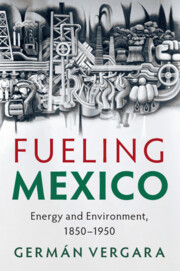Description
Fueling Mexico
Energy and Environment, 1850–1950
Studies in Environment and History Series
Author: Vergara Germán
Germán Vergara explains how, when, and why fossil fuels (oil, coal, and natural gas) became the basis of Mexican society.
Language: English
Subject for Fueling Mexico:
Approximative price 30.28 €
In Print (Delivery period: 14 days).
Add to cart
Fueling Mexico
Publication date: 12-2022
Support: Print on demand
Publication date: 12-2022
Support: Print on demand
Fueling Mexico
Publication date: 06-2021
300 p. · 15.7x23.5 cm · Hardback
Publication date: 06-2021
300 p. · 15.7x23.5 cm · Hardback
Description
/li>Contents
/li>Biography
/li>
Around the 1830s, parts of Mexico began industrializing using water and wood. By the 1880s, this model faced a growing energy and ecological bottleneck. By the 1950s, fossil fuels powered most of Mexico's economy and society. Looking to the north and across the Atlantic, late nineteenth-century officials and elites concluded that fossil fuels would solve Mexico's energy problem and Mexican industry began introducing coal. But limited domestic deposits and high costs meant that coal never became king in Mexico. Oil instead became the favored fuel for manufacture, transport, and electricity generation. This shift, however, created a paradox of perennial scarcity amidst energy abundance: every new influx of fossil energy led to increased demand. Germán Vergara shows how the decision to power the country's economy with fossil fuels locked Mexico in a cycle of endless, fossil-fueled growth - with serious environmental and social consequences.
1. Introduction: Energy, environment, and history; 2. 1850s: Solar society; 3. The nature of growth; 4. Searching for rocks; 5. The other revolution; 6. 1950s: Fossil-fueled society; Conclusion; Index.
Germán Vergara is Assistant Professor of History at the Georgia Institute of Technology.
© 2024 LAVOISIER S.A.S.

